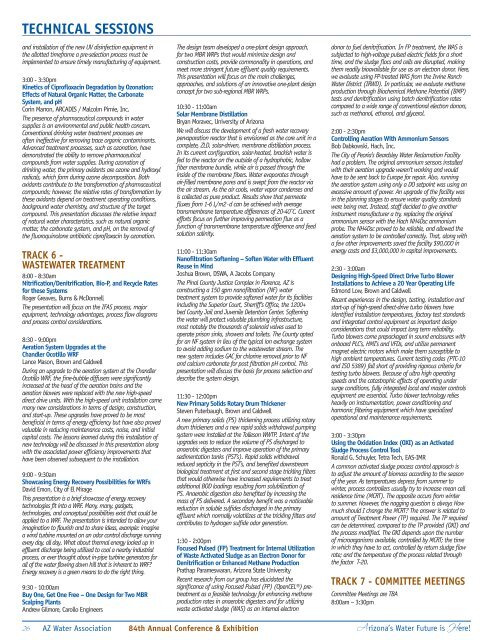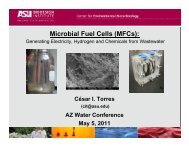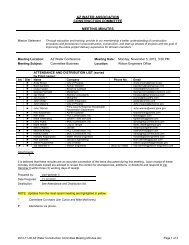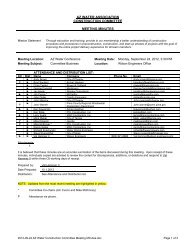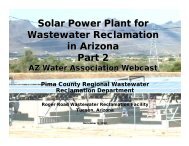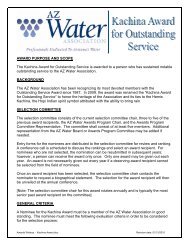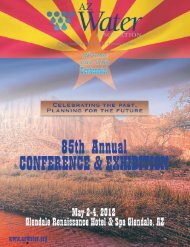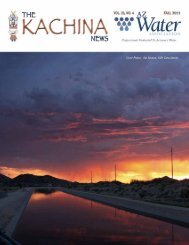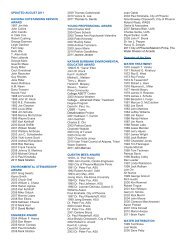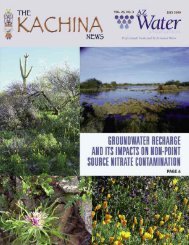Annual Conference Brochure - AZ Water Association
Annual Conference Brochure - AZ Water Association
Annual Conference Brochure - AZ Water Association
You also want an ePaper? Increase the reach of your titles
YUMPU automatically turns print PDFs into web optimized ePapers that Google loves.
TECHNICAL SESSIONS<br />
and installation of the new UV disinfection equipment in<br />
the allotted timeframe a pre-selection process must be<br />
implemented to ensure timely manufacturing of equipment.<br />
3:00 - 3:30pm<br />
Kinetics of Ciprofloxacin Degradation by Ozonation:<br />
Effects of Natural Organic Matter, the Carbonate<br />
System, and pH<br />
Corin Marron, ARCADIS / Malcolm Pirnie, Inc.<br />
The presence of pharmaceutical compounds in water<br />
supplies is an environmental and public health concern.<br />
Conventional drinking water treatment processes are<br />
often ineffective for removing trace organic contaminants.<br />
Advanced treatment processes, such as ozonation, have<br />
demonstrated the ability to remove pharmaceutical<br />
compounds from water supplies. During ozonation of<br />
drinking water, the primary oxidants are ozone and hydroxyl<br />
radicals, which form during ozone decomposition. Both<br />
oxidants contribute to the transformation of pharmaceutical<br />
compounds; however, the relative rates of transformation by<br />
these oxidants depend on treatment operating conditions,<br />
background water chemistry, and structure of the target<br />
compound. This presentation discusses the relative impact<br />
of natural water characteristics, such as natural organic<br />
matter, the carbonate system, and pH, on the removal of<br />
the fluoroquinolone antibiotic ciprofloxacin by ozonation.<br />
TRACK 6 -<br />
WASTEWATER TREATMENT<br />
8:00 - 8:30am<br />
Nitrification/Denitrification, Bio-P, and Recycle Rates<br />
for these Systems<br />
Roger Greaves, Burns & McDonnell<br />
The presentation will focus on the IFAS process, major<br />
equipment, technology advantages, process flow diagrams<br />
and process control considerations.<br />
8:30 - 9:00pm<br />
Aeration System Upgrades at the<br />
Chandler Ocotillo WRF<br />
Lance Mason, Brown and Caldwell<br />
During an upgrade to the aeration system at the Chandler<br />
Ocotillo WRF, the fine-bubble diffusers were significantly<br />
increased at the head of the aeration trains and the<br />
aeration blowers were replaced with the new high-speed<br />
direct drive units. With the high-speed unit installation came<br />
many new considerations in terms of design, construction,<br />
and start-up. These upgrades have proved to be most<br />
beneficial in terms of energy efficiency but have also proved<br />
valuable in reducing maintenance costs, noise, and initial<br />
capital costs. The lessons learned during this installation of<br />
new technology will be discussed in this presentation along<br />
with the associated power efficiency improvements that<br />
have been observed subsequent to the installation.<br />
9:00 - 9:30am<br />
Showcasing Energy Recovery Possibilities for WRFs<br />
David Emon, City of El Mirage<br />
This presentation is a brief showcase of energy recovery<br />
technologies fit into a WRF. Many, many, gadgets,<br />
technologies, and conceptual possibilities exist that could be<br />
applied to a WRF. The presentation is intended to allow your<br />
imagination to flourish and to share ideas, example: imagine<br />
a wind turbine mounted on an odor control discharge running<br />
every day, all day. What about thermal energy locked up in<br />
effluent discharge being utilized to cool a nearby industrial<br />
process, or ever thought about in-pipe turbine generators for<br />
all of the water flowing down hill that is inherent to WRF?<br />
Energy recovery is a green means to do the right thing.<br />
9:30 - 10:00am<br />
Buy One, Get One Free – One Design for Two MBR<br />
Scalping Plants<br />
Andrew Gilmore, Carollo Engineers<br />
26<br />
The design team developed a one-plant design approach,<br />
for two MBR WRPs that would minimize design and<br />
construction costs, provide commonality in operations, and<br />
meet more stringent future effluent quality requirements.<br />
This presentation will focus on the main challenges,<br />
approaches, and solutions of an innovative one-plant design<br />
concept for two sub-regional MBR WRPs.<br />
10:30 - 11:00am<br />
Solar Membrane Distillation<br />
Bryan Moravec, University of Arizona<br />
We will discuss the development of a fresh water recovery<br />
pervaporation reactor that is envisioned as the core unit in a<br />
complete, ZLD, solar-driven, membrane distillation process.<br />
In its current configuration, solar-heated, brackish water is<br />
fed to the reactor on the outside of a hydrophobic, hollow<br />
fiber membrane bundle, while air is passed through the<br />
inside of the membrane fibers. <strong>Water</strong> evaporates through<br />
air-filled membrane pores and is swept from the reactor via<br />
the air stream. As the air cools, water vapor condenses and<br />
is collected as pure product. Results show that permeate<br />
fluxes from 1-6 L/m2∙d can be achieved with average<br />
transmembrane temperature differences of 20-40˚C. Current<br />
efforts focus on further improving permeation flux as a<br />
function of transmembrane temperature difference and feed<br />
solution salinity.<br />
11:00 - 11:30am<br />
Nanofiltration Softening – Soften <strong>Water</strong> with Effluent<br />
Reuse in Mind<br />
Joshua Brown, DSWA, A Jacobs Company<br />
The Pinal County Justice Complex in Florence, <strong>AZ</strong> is<br />
constructing a 150 gpm nanofiltration (NF) water<br />
treatment system to provide softened water for its facilities<br />
including the Superior Court, Sherriff’s Office, the 1200+<br />
bed County Jail and Juvenile Detention Center. Softening<br />
the water will protect valuable plumbing infrastructure,<br />
most notably the thousands of solenoid valves used to<br />
operate prison sinks, showers and toilets. The County opted<br />
for an NF system in lieu of the typical ion exchange system<br />
to avoid adding sodium to the wastewater stream. The<br />
new system includes GAC for chlorine removal prior to NF<br />
and calcium carbonate for post filtration pH control. This<br />
presentation will discuss the basis for process selection and<br />
describe the system design.<br />
11:30 - 12:00pm<br />
New Primary Solids Rotary Drum Thickener<br />
Steven Puterbaugh, Brown and Caldwell<br />
A new primary solids (PS) thickening process utilizing rotary<br />
drum thickeners and a new rapid solids withdrawal pumping<br />
system were installed at the Tolleson WWTP. Intent of the<br />
upgrades was to reduce the volume of PS discharged to<br />
anaerobic digesters and improve operation of the primary<br />
sedimentation tanks (PST’s). Rapid solids withdrawal<br />
reduced septicity in the PST’s, and benefited downstream<br />
biological treatment at first and second stage trickling filters<br />
that would otherwise have increased requirements to treat<br />
additional BOD loadings resulting from solubilization of<br />
PS. Anaerobic digestion also benefited by increasing the<br />
mass of PS delivered. A secondary benefit was a noticeable<br />
reduction in soluble sulfides discharged in the primary<br />
effluent which normally volatilizes at the trickling filters and<br />
contributes to hydrogen sulfide odor generation.<br />
1:30 - 2:00pm<br />
Focused Pulsed (FP) Treatment for Internal Utilization<br />
of Waste Activated Sludge as an Electron Donor for<br />
Denitrification or Enhanced Methane Production<br />
Prathap Parameswaran, Arizona State University<br />
Recent research from our group has elucidated the<br />
significance of using Focused Pulsed (FP) (OpenCEL®) pretreatment<br />
as a feasible technology for enhancing methane<br />
production rates in anaerobic digesters and for utilizing<br />
waste activated sludge (WAS) as an internal electron<br />
donor to fuel denitrification. In FP treatment, the WAS is<br />
subjected to high-voltage pulsed electric fields for a short<br />
time, and the sludge flocs and cells are disrupted, making<br />
them readily bioavailable for use as an electron donor. Here,<br />
we evaluate using FP-treated WAS from the Irvine Ranch<br />
<strong>Water</strong> District (IRWD). In particular, we evaluate methane<br />
production through Biochemical Methane Potential (BMP)<br />
tests and denitrification using batch denitrification rates<br />
compared to a wide range of conventional electron donors,<br />
such as methanol, ethanol, and glycerol.<br />
2:00 - 2:30pm<br />
Controlling Aeration With Ammonium Sensors<br />
Bob Dabkowski, Hach, Inc.<br />
The City of Peoria’s Beardsley <strong>Water</strong> Reclamation Facility<br />
had a problem. The original ammonium sensors installed<br />
with their aeration upgrade weren’t working and would<br />
have to be sent back to Europe for repair. Also, running<br />
the aeration system using only a DO setpoint was using an<br />
excessive amount of power. An upgrade of the facility was<br />
in the planning stages to ensure water quality standards<br />
were being met. Instead, staff decided to give another<br />
instrument manufacturer a try, replacing the original<br />
ammonium sensor with the Hach NH4Dsc ammonium<br />
probe. The NH4Dsc proved to be reliable, and allowed the<br />
aeration system to be controlled correctly. That, along with<br />
a few other improvements saved the facility $90,000 in<br />
energy costs and $3,000,000 in capital improvements.<br />
2:30 - 3:00am<br />
Designing High-Speed Direct Drive Turbo Blower<br />
Installations to Achieve a 20 Year Operating Life<br />
Edmond Low, Brown and Caldwell<br />
Recent experiences in the design, testing, installation and<br />
start-up of high-speed direct-drive turbo blowers have<br />
identified installation temperatures, factory test standards<br />
and integrated control equipment as important design<br />
considerations that could impact long term reliability.<br />
Turbo blowers come prepackaged in sound enclosures with<br />
onboard PLC’s, HMI’s and VFDs, and utilize permanent<br />
magnet electric motors which make them susceptible to<br />
high ambient temperatures. Current testing codes (PTC-10<br />
and ISO 5389) fall short of providing rigorous criteria for<br />
testing turbo blowers. Because of ultra high operating<br />
speeds and the catastrophic effects of operating under<br />
surge conditions, fully integrated local and master controls<br />
equipment are essential. Turbo blower technology relies<br />
heavily on instrumentation, power conditioning and<br />
harmonic filtering equipment which have specialized<br />
operational and maintenance requirements.<br />
3:00 - 3:30pm<br />
Using the Oxidation Index (OXI) as an Activated<br />
Sludge Process Control Tool<br />
Ronald G. Schuyler, Tetra Tech, EAS-IMR<br />
A common activated sludge process control approach is<br />
to adjust the amount of biomass according to the season<br />
of the year. As temperatures depress from summer to<br />
winter, process controllers usually try to increase mean cell<br />
residence time (MCRT). The opposite occurs from winter<br />
to summer. However, the nagging question is always How<br />
much should I change the MCRT? The answer is related to<br />
amount of Treatment Power (TP) required. The TP required<br />
can be determined, compared to the TP provided (OXI) and<br />
the process modified. The OXI depends upon the number<br />
of microorganisms available, controlled by MCRT; the time<br />
in which they have to act, controlled by return sludge flow<br />
rate; and the temperature of the process related through<br />
the factor ‐T-20.<br />
TRACK 7 - COMMITTEE MEETINGS<br />
Committee Meetings are TBA<br />
8:00am – 3:30pm<br />
<strong>AZ</strong> <strong>Water</strong> <strong>Association</strong> 84th <strong>Annual</strong> <strong>Conference</strong> & Exhibition Arizona’s <strong>Water</strong> Future is Here!


